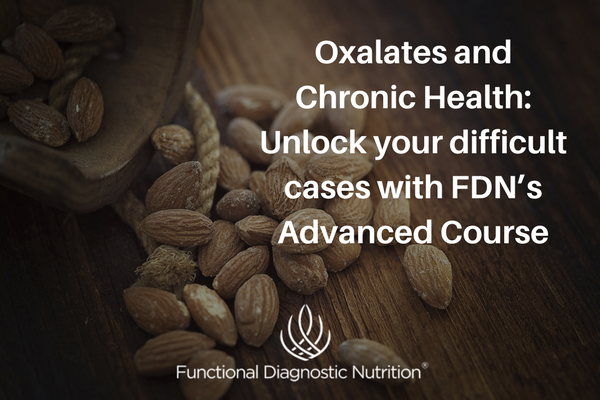Slow or halting progress can be frustrating for both client and practitioner. Nothing is more discouraging than working hard and getting results that don’t hold or have limited improvement. Oxalates complicate cases and tend to throw us off the trail. Clients who work the hardest often suffer the most because they unwittingly load up on oxalates in an effort to eat healthy, exacerbating their issues. Most of the foods recommended on a typical healthy diet are high oxalate, presenting a challenge for dedicated people. These clients continue to deal with pain, fatigue and other symptoms, and they might see new symptoms develop. Be the practitioner who can unlock this mystery. The FDN Advanced course on Oxalates provides the information you need to move your case forward.
What are oxalates?
Oxalates are molecules that appear as sharp crystals in the body, mostly found in plant foods. The human body also produces them. They come from without and within: exogenous contribution from diet and endogenous production.
Oxalates are structure and defense for the plant. The acidic, chalky taste of spinach is due to its high oxalate content. Plants with high oxalates are naturally bug resistant because the crystals destroy bug teeth and kill the bugs who try to eat them.
Oxalate (oxalic acid) is poison. It is used as a corrosive agent in rust removal and can also be found in things like anti-freeze. The CDC lists the lowest lethal dose of oxalic acid between 15 and 30 grams.
Many health-conscious people easily consume 1500mg of oxalic acid in one meal consisting of a green smoothie with spinach, almonds, chia seeds, and maybe a muffin made with almond or buckwheat flour. One meal could provide one tenth of a lethal dose! A day in the life of a healthy eater might include that green smoothie, quinoa flatbread, brown rice, more greens and high oxalate vegetables with potatoes for dinner.
These clients could gain weight in spite of the huge effort they make. Joint pain, fatigue, brain fog, memory loss, would be a few of the symptoms they might experience. They might also experience hormone imbalance, endocrine issues, intractable yeast infections, cortisol disturbances and inflammation. Initially, they feel better because they eliminated allergy and autoimmune triggers, but as their oxalate load piles on, they feel worse with new symptoms appearing. Part of the confusion is that the initial diet change is deceiving.
Common Symptoms Associated with Oxalates
- Bladder, kidney, urinary tract:
- Genital (vulvodynia) – a burning sensation, not caused by infection
- Frequent urination, urinary pain, Interstitial Cystitis
- Cloudy urine, crystals in urine, or sandy stools
- Kidney Stones
- Pain:
- Anywhere in the body.
- Sharp, stabbing pain in lower extremities.
- Joints, muscles, eyes, head, & intestines
- Painful or inflamed joints and muscles (Fibromyalgia or arthritis)
- Burning Sensations in the Feet
- Eye pain
- Fatigue
- Insomnia
- Low bone density
- Mental/emotional:
- Depression
- Anxiety
- Brain Fog
- Yeast Overgrowth
- Skin:
- Rashes
- Hives
Unbound oxalates make their way into cells where they damage mitochondria and cause fatigue. Once cell metabolism is affected, many chronic systemic symptoms develop. Much of the available literature written about oxalates focuses on the formation of kidney stones, but it’s important to realize it can also cause chronic health problems, and kidney stones may not even be present.
Since oxalates lodge in tissues, the pain or complications can present in various ways. There are many interactions with genetics and micronutrients, and individual correlation plays a huge role in unlocking the specific issues that need to be addressed. The above is a list of common symptoms, but everyone is affected slightly differently, depending on how they arrived at hyperoxaluria.
What Causes the Problem?
Ingested oxalates only account for about 20% of total oxalate load. What contributes to the other 80% endogenous production?
Compromised gut health: Hyperoxaluria (high oxalate in urine) can be a byproduct of leaky gut. Undigested, high oxalate foods leach directly into the blood stream. Inflammation in the gut lining also allows oxalates to be absorbed.
Dysbiosis: Low levels of good bacteria and high levels of bad bacteria contribute to the conditions that cause oxalate formation.
Antibiotic use, and the use of other medications: Medications can destroy strains of bacteria that are able to degrade oxalates and break them down in the intestines.
Genetic SNPs: Some people produce a high amount of oxalates. Supporting metabolic pathways with B1, B6, B12, vitamin A, and sulfate is part of an overall approach. Testing for these deficiencies would be part of dealing with the bio individuality of that client.
Minerals: Minerals interact with oxalates in a feedback loop. Which came first? The mineral deficiency caused by high oxalates, or the high oxalates caused by a mineral deficiency? Minerals bind with oxalates and carry them safely out of our bodies, or you could say that oxalates bind with minerals making them unavailable for absorption.
Fat malabsorption: Undigested fat floating around in the gut tends to bind with calcium, making calcium unavailable to bind with oxalate, or unavailable for absorption. A stool analysis would determine if this is a problem.
Yeast and fungal overgrowth: These organisms can trigger the formation of oxalates. Environmental exposure to mold can also contribute.
Other foods and supplements can be converted into oxalates. Ascorbic acid, glycine (in bone broth), collagen (also in bone broth), fructose, and xylitol are on this list.
Who Should be Tested for Oxalates?
- Autistic Children
- People with leaky gut
- People with genetic SNPs
- People with micronutrient deficiencies, such as B1, B6, calcium, magnesium, iron, and zinc
- Anyone with a history of antibiotic use
- Anyone with a yeast infection that doesn’t respond to normal treatment
- Unexplained pain anywhere in the body
- Vegetarians with chronic health problems, and people who have switched to a healthier diet, but are still having trouble getting well
- People with learning disabilities
What Tests Are Used?
- Great Plains Laboratory Organic Acids Test
- GI Pathogen Stool Analysis
- Micronutrient Test
- Zinc/Copper Profile
- Urinary Pyrrole Test
A Strategy for Lowering Oxalate Levels
Following a low oxalate diet can be difficult. There is information in the FDN course, and more information about lowering oxalates can be found on the Trying Low Oxalates Facebook group and at lowoxalate.info.
Reducing dietary intake slowly is very important. Dumping large amounts of oxalate can damage organs and tissues. Clearing oxalates from the blood allows the body to dump them from tissues. A low oxalate diet does not directly lower body burden, but it enables the body to clear them. Eating a small amount of high oxalate food may be necessary at times to slow the process down. Clients need to understand that dumping too much or too fast is not safe.
Taking minerals, such as calcium citrate, before meals binds up oxalates in food and stops food from adding to the burden.
Supplementation aimed at correcting micronutrient deficiency and supporting genetic metabolism is important, and it might make sense to begin a program with that support before lowering the amount through diet.
Correcting dysbiosis and using specific strains of probiotics to break down oxalates can be a vital part of the program.
Address yeast and fungi overgrowth.
Why You Should Take the FDN Advanced Course
The FDN Advanced Course on Oxalates will help you identify which clients need help, what their specific contributing issues are, and how to gain control over these difficult problems. There is not much information in circulation about how to manage oxalates. FDN’s Advanced Course is a great way to get a complete information package and arm yourself with the ability to truly help people that few other practitioners are equipped to help.
- Sources:
“The National Institute for Occupational Safety and Health (NIOSH).”Centers for Disease Control and Prevention, Centers for Disease Control and Prevention, 4 Dec. 2014, www.cdc.gov/niosh/idlh/144627.html.
- Owens, Susan. “What Is Oxalate?” Home-Low Oxalate Diet, www.lowoxalate.info/.







